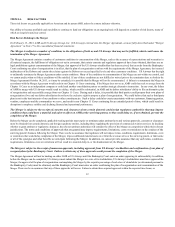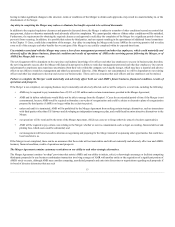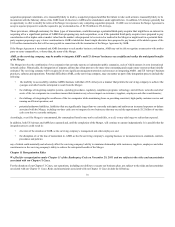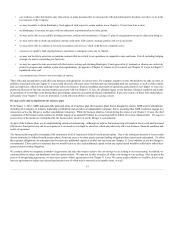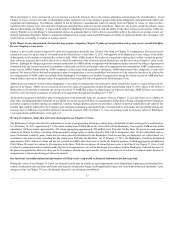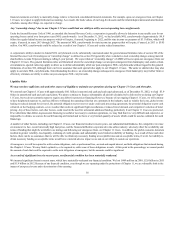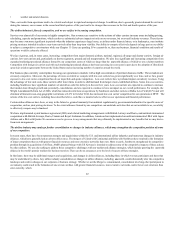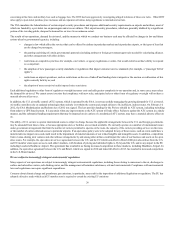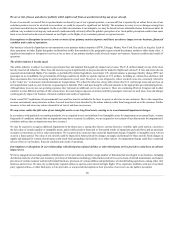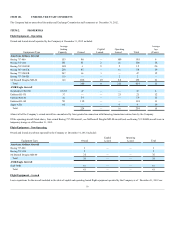American Airlines 2012 Annual Report Download - page 22
Download and view the complete annual report
Please find page 22 of the 2012 American Airlines annual report below. You can navigate through the pages in the report by either clicking on the pages listed below, or by using the keyword search tool below to find specific information within the annual report.
•weather and natural disasters.
Thus, our results from operations tend to be volatile and subject to rapid and unexpected change. In addition, due to generally greater demand for air travel
during the summer, our revenues in the second and third quarters of the year tend to be stronger than revenues in the first and fourth quarters of the year.
The airline industry is fiercely competitive, and we are subject to increasing competition.
Service over almost all of our routes is highly competitive. Our revenues are sensitive to the actions of other carriers in many areas including pricing,
scheduling, capacity and promotions, which can have a substantial adverse impact not only on our revenues, but on overall industry revenues. These factors
may become even more significant in periods when the industry experiences large losses, as airlines under financial stress, or in bankruptcy, may institute
pricing structures intended to achieve near-term survival rather than long-term viability. Our ability to compete effectively depends in large part on our ability
to achieve a competitive cost structure while our Chapter 11 Cases are pending. If we cannot do so, then our business, financial condition and results of
operations would be adversely affected.
We face vigorous, and, in some cases, increasing, competition from major domestic airlines, national, regional, all-cargo and charter carriers, foreign air
carriers, low-cost carriers and, particularly on shorter segments, ground and rail transportation. We also face significant and increasing competition from
expanded marketing/operational alliances formed by our competitors (some of which are larger than the oneworld alliance, of which we are a charter member).
Competition with foreign air carriers and with such marketing/operational alliances has been increasing in recent years in part due to the adoption of liberalized
open skies aviation agreements between the United States and an increasing number of countries around the world.
Our business plan currently contemplates focusing our operations in markets with a high concentration of premium business traffic. These markets are
extremely competitive. Moreover, the percentage of routes on which we compete with low-cost carriers has grown significantly over time, and we face greater
exposure to low-cost carrier competition than do our major hub-and-spoke competitors. Low-cost carriers have a profound impact on industry revenues. Using
the advantage of low unit costs, these carriers offer lower fares in order to shift demand from larger, more-established airlines. Some low-cost carriers,
including Southwest, have significant numbers of aircraft on order for delivery in the next few years. Low-cost carriers are expected to continue to increase
their market share through growth and, potentially, consolidation, and are expected to continue to have an impact on our overall performance. For example, the
Wright Amendment Reform Act of 2006, which has reduced restrictions on operations by Southwest and other carriers at Dallas Love Field (LUV) and will
eliminate all domestic non-stop geographic restrictions at LUV in October 2014, has increased low-cost carrier competition for our operations at DFW. The
actions of the low-cost carriers, including those described above, could have a material adverse effect on our operations and financial performance.
Certain airline alliances have been, or may in the future be, granted immunity from antitrust regulations by governmental authorities for specific areas of
cooperation, such as joint pricing decisions. To the extent alliances formed by our competitors can undertake activities that are not available to us, our ability
to effectively compete may be hindered.
We have implemented a joint business agreement (JBA) and related marketing arrangements with British Airways and Iberia, and antitrust-immunized
cooperation with British Airways, Iberia, Finnair and Royal Jordanian. In addition, American has implemented an antitrust-immunized JBA with Japan
Airlines and a JBA with Qantas. No assurances can be given as to any arrangements that may ultimately be implemented or any benefits that we may derive
from such arrangements.
The airline industry may undergo further consolidation or changes in industry alliances, which may strengthen the competitive position of some
of our competitors.
In recent years, there have been numerous mergers and acquisitions within the U.S. and international airline industries and numerous changes in industry
alliances, which have generally had an adverse effect on us. The mergers of United with Continental and Delta with Northwest have resulted in the formation
of larger competitors than us with greater financial resources and more extensive networks than ours. More recently, Southwest strengthened its competitive
position through its acquisition of AirTran. AMR's planned Merger with US Airways is intended to address some of the competitive impacts of these actions
by other airlines. We are also seeking to address these competitive challenges with our market and alliance strategies, which include growing the oneworld
alliance in the world's premier markets for business travelers. There can be no assurances as to the level of success of these strategies.
In the future, there may be additional mergers and acquisitions, and changes in airline alliances, including those in which we may participate and those that
may be undertaken by others. Any airline industry consolidation or changes in airline alliances, including oneworld, could substantially alter the competitive
landscape and result in changes in our corporate or business strategy. Whether or not the Merger is consummated, consolidation involving other participants in
our industry could result in the formation of one or more airlines with greater financial resources, more extensive networks, and/or lower cost structures than
exist currently, which
22


